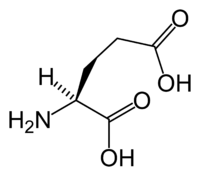
Photo from wikipedia
Glutamate receptors (GluRs) located primarily on the membranes of neurons and glial cells are responsible for excitatory synaptic transmission in the central nervous system. The transport of GluRs to the… Click to show full abstract
Glutamate receptors (GluRs) located primarily on the membranes of neurons and glial cells are responsible for excitatory synaptic transmission in the central nervous system. The transport of GluRs to the cell surface is a highly regulated dynamic process that determines neuronal excitability and synaptic responses. The molecular and cellular mechanisms of GluR trafficking are often studied in cell cultures. These studies require sensitive techniques that allow the measurement of total and surface-expressed GluRs in cell populations. The cell-based enzyme-linked immunosorbent assay (cell-ELISA) combines steps of direct immunochemical labelling of cell cultures and ELISA. It can be used for quantitative comparisons of surface-expressed and total protein contents of various cell cultures. While several cell-ELISA protocols are available for different cell types, in this chapter we describe the procedure that we have applied for the investigation of quantitative changes in the cell surface expression of recombinant ionotropic glutamate receptors (iGluRs) in adherent human embryonic kidney 293 (HEK293) cells and endogenous iGluR proteins in primary neuronal cultures.
Journal Title: Methods in molecular biology
Year Published: 2019
Link to full text (if available)
Share on Social Media: Sign Up to like & get
recommendations!